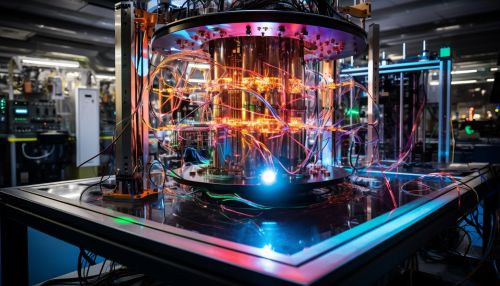Quantum Computing with Quantum Optomechanical Systems under Quantum Simulation
Introduction
Quantum computing is a field of study focused on the development of computer-based technologies centered around the principles of quantum theory. Quantum theory explains the nature and behavior of energy and matter on the quantum (atomic and subatomic) level. Quantum computing uses a combination of bits to perform specific computational tasks. All computing systems rely on a fundamental ability to store and manipulate information. Current computers manipulate individual bits, which store information as binary 0 and 1 states. Quantum computers, however, leverage quantum mechanical phenomena to manipulate information. To do this, they rely on quantum bits, or "qubits". Qubits represent atoms, ions, photons or electrons and their respective control devices that are working together to act as computer memory and a processor. Because a quantum computer can contain these multiple states simultaneously, it has the potential to be millions of times more powerful than today's most powerful supercomputers.


Quantum Optomechanical Systems
Quantum optomechanical systems are physical systems in which the mechanical motion of an object is coupled to the field of an optical (or microwave) cavity. These systems have been used to achieve a variety of quantum phenomena, including ground-state cooling, strong coupling, and quantum non-demolition measurements. The interaction between light and mechanical motion in these systems can be described by the optomechanical Hamiltonian, which can be derived from the laws of quantum mechanics. The study of these systems is a rapidly growing field, with potential applications in quantum information processing, quantum sensing, and quantum simulation.
Quantum Simulation
Quantum simulation is a subfield of quantum computing that uses a quantum computer to simulate the quantum behavior of a physical system. This is in contrast to classical simulation, which uses a classical computer to simulate the behavior of a physical system. Quantum simulation is a powerful tool for understanding quantum systems that are difficult to study in the lab or to model with classical computers. This includes systems with many interacting particles, such as many-body quantum systems, and systems with exotic quantum phases of matter.
Quantum Computing with Quantum Optomechanical Systems
Quantum optomechanical systems provide a promising platform for quantum computing. These systems allow for the manipulation of qubits using light, which can be controlled with high precision. This allows for the implementation of quantum gates, the basic building blocks of a quantum computer. Furthermore, the mechanical motion of the system can be used to store quantum information, providing a form of quantum memory.
One of the key challenges in quantum computing is maintaining quantum coherence, the delicate state in which qubits can exist in a superposition of states. Quantum optomechanical systems have been shown to have long coherence times, making them a promising platform for quantum computing.
Quantum Simulation with Quantum Optomechanical Systems
Quantum optomechanical systems also provide a powerful platform for quantum simulation. These systems can be used to simulate a variety of quantum systems, including many-body quantum systems and quantum phases of matter. This can provide insights into these complex systems that are difficult to obtain through other means.
One of the key advantages of quantum simulation with quantum optomechanical systems is the ability to tune the system parameters. This allows for the exploration of different regimes of the simulated quantum system, providing a deeper understanding of its behavior.
Future Directions
The field of quantum computing with quantum optomechanical systems is still in its early stages, and there are many exciting directions for future research. These include the development of new quantum algorithms, the exploration of new quantum phases of matter, and the development of new quantum technologies.
One of the key challenges for the field is the development of scalable quantum optomechanical systems. This will require advances in both the design and fabrication of these systems, as well as the development of new techniques for controlling and manipulating qubits.
